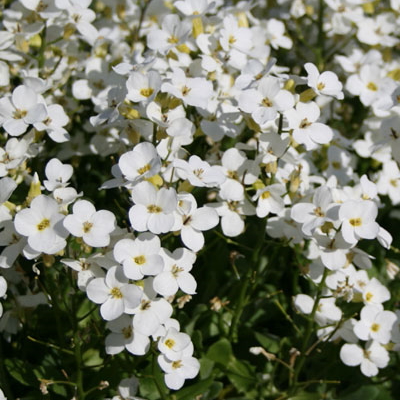-
 Aster Alpine Mix Aster Alpinus is a compact perennial with a spreading growth habit. It is easy to grow Alpine Aster from seeds, and this particular variety produces masses of lavender, blue, pink, and white flowers with yellow centers on a top of dark-green, lance-like foliage. Aster Alpine Mix blooms for several weeks from late spring and into fall providing a colorful display and attracting bees and butterflies. Alpine Aster looks gorgeous in mass planting, rock, and alpine gardens, containers, and borders. Aster Alpinus grows best in full sun to partial shade, and this drought-tolerant perennial is suitable for a low-water garden or xeriscape landscaping.
Aster Alpine Mix Aster Alpinus is a compact perennial with a spreading growth habit. It is easy to grow Alpine Aster from seeds, and this particular variety produces masses of lavender, blue, pink, and white flowers with yellow centers on a top of dark-green, lance-like foliage. Aster Alpine Mix blooms for several weeks from late spring and into fall providing a colorful display and attracting bees and butterflies. Alpine Aster looks gorgeous in mass planting, rock, and alpine gardens, containers, and borders. Aster Alpinus grows best in full sun to partial shade, and this drought-tolerant perennial is suitable for a low-water garden or xeriscape landscaping. -
-
 Arabis Snow Cap (rock Cress) Seeds have masses of tiny, snow-white fragrant flowers that appear in early spring starting April through May/June against a backdrop of evergreen foliage. The silvery-green foliage is 15-20 cm tall. Foilage provides an excellent ground cover all season long. Thin plants to 15 cm apart when transplanting or thinning out seedlings. To keep plant compact shear down all foliage after flowering.
Arabis Snow Cap (rock Cress) Seeds have masses of tiny, snow-white fragrant flowers that appear in early spring starting April through May/June against a backdrop of evergreen foliage. The silvery-green foliage is 15-20 cm tall. Foilage provides an excellent ground cover all season long. Thin plants to 15 cm apart when transplanting or thinning out seedlings. To keep plant compact shear down all foliage after flowering. -
 Aubrieta (Aubrieta deltoidea) is one of the earliest bloomers in spring. Often part of a rock garden, Aubretia is also known as "false rockcress". With its darling little purple flowers and dainty leaves, Aubrieta will scramble over rocks and other inorganic items, covering them with color and distracting the eye. Aubrieta groundcover is also remarkably drought tolerant once established and can handle the harsh heat of a full sun rockery. Read on for some tips on the care of Aubrieta and how to use this magical little plant in the garden.
Aubrieta (Aubrieta deltoidea) is one of the earliest bloomers in spring. Often part of a rock garden, Aubretia is also known as "false rockcress". With its darling little purple flowers and dainty leaves, Aubrieta will scramble over rocks and other inorganic items, covering them with color and distracting the eye. Aubrieta groundcover is also remarkably drought tolerant once established and can handle the harsh heat of a full sun rockery. Read on for some tips on the care of Aubrieta and how to use this magical little plant in the garden. -
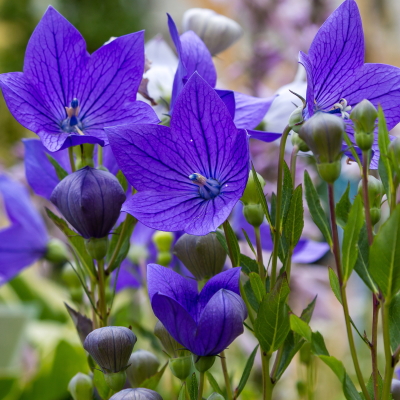
Balloon Flower (Platycodon grandiflorus) Easy-to-grow from flower seed, Balloon Flowers are an old-fashioned favorite, and they are as lovely in the garden as they are in the vase. This flower has unique star-shaped blue blossoms, and it blooms late summer and into the fall. Platycodon Grandiflorus has been around forever. The buds form like balloons and then grow until the right time to pop open and form the lovely star-shaped flower. Balloon Flower plants are very hardy perennials that can withstand periods of drought, and they are rarely bothered by disease or insect problems making them virtually a maintenance-free perennial.
-
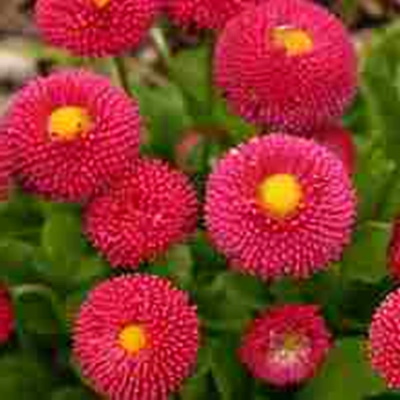
A perennial plant, grown as a biennial, 10-20 cm in height. Inflorescences with a diameter of 2-6 cm, raspberry-red color. Sow seeds for seedlings in May-June, transplanted to a permanent place in the fall. Abundant and friendly flowering of daisies occurs next year from May to August. It grows well in sunny places and in partial shade. Used for decoration of balconies, terraces, flower beds, and lawns.
-

A perennial plant 10-20 cm in height. Flowers are 2-6 cm and have multi-layered snow-white petals with a bright yellow button centre. Sow seeds for seedlings in May-June, transplanted to a permanent place in the fall. Abundant and friendly flowering of daisies occurs next year from May to August. It grows well in sunny places and in partial shade. Used for decoration of balconies, terraces, flower beds, and lawns.
-

The button-shaped flowers with double blossoms of white, pink, and rose are showy and fragrant. The small plants are dainty and attractive for spring through early summer bloom. Compact 10-20 cm plants make great for edging and in rocky gardens. Mulch heavy in winter. Plants may have single and double blooms.
-
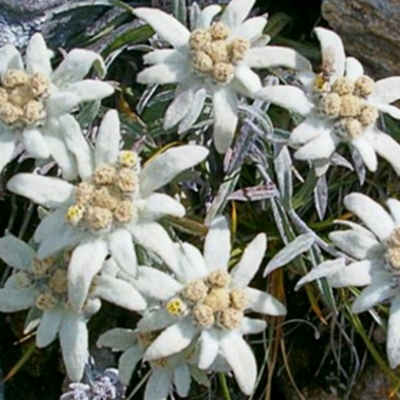 Edelweiss Leontopodium Alpinum is a famous, short-lived, herbaceous perennial native to alpine areas of Europe. Edelweiss seeds can be sown indoors 4-6 weeks before the last frost, so seedlings can be transplanted outdoors after the last frost. So-called Edelweiss of the Alps is a clamping, woolly perennial wildflower with highly attractive gray-green foliage and small yellow flowers that seat on a top of showy, fluffy, white-woolly, bract-like leaves, and this highly attractive combination is shaped like a lion's paw. Edelweiss starts to bloom in the summer. The established Edelweiss likes to grow in full sun, and cool summer climates are preferable environments.
Edelweiss Leontopodium Alpinum is a famous, short-lived, herbaceous perennial native to alpine areas of Europe. Edelweiss seeds can be sown indoors 4-6 weeks before the last frost, so seedlings can be transplanted outdoors after the last frost. So-called Edelweiss of the Alps is a clamping, woolly perennial wildflower with highly attractive gray-green foliage and small yellow flowers that seat on a top of showy, fluffy, white-woolly, bract-like leaves, and this highly attractive combination is shaped like a lion's paw. Edelweiss starts to bloom in the summer. The established Edelweiss likes to grow in full sun, and cool summer climates are preferable environments. -
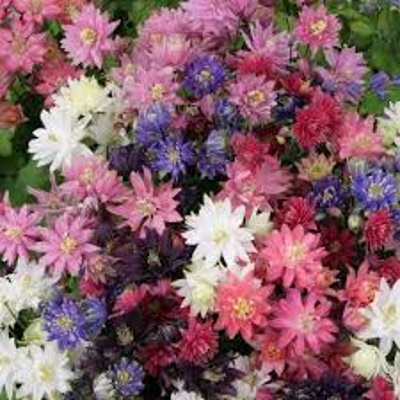
Clematis-flowered columbine. Fluffy, star-shaped blooms with pointed, overlapping petals resemble petite clematis flowers. Fully double 3-4 cm upward-facing and nodding, spurless flowers. Blooms late spring of the second year from a spring sowing. An excellent cut flower, it has strong, straight stems and fills the gap between early spring and summer bouquets. Produces multiple blooms per stem. The mix includes Victorian shades in a complementary color palette: rose, almost black, violet, deep wine red, dark purple, white, and purple-edged white. Attracts hummingbirds.
-
-
 One of the easiest native wildflowers to grow from seed, Blue Flax adds charming, light blue blooms to the early season garden. Growing to be only 45-70 cm tall, this perennial is perfect for the front of the meadow or a small space garden. Very tolerant of sandy, dry soils, Blue Flax will grow in almost any sunny spot.
One of the easiest native wildflowers to grow from seed, Blue Flax adds charming, light blue blooms to the early season garden. Growing to be only 45-70 cm tall, this perennial is perfect for the front of the meadow or a small space garden. Very tolerant of sandy, dry soils, Blue Flax will grow in almost any sunny spot. -
Out of stock
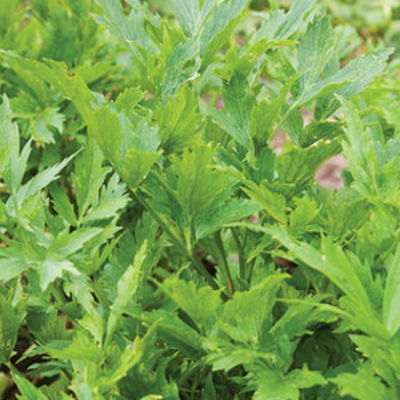
Specialty culinary herb. Young leaves taste like celery and are used in spring salads and with potato, rice, and poultry dishes. Roots and young stems are also edible. Young stems can be cut, peeled, and used in salads. Stems are smooth, hollow, and thick. Attracts Beneficial Insects: If allowed to flower, provides pollen and nectar for beneficial insects such as bees, hoverflies, lacewing larva, lady beetles, parasitic wasps, and tachinid flies.
-
Out of stock
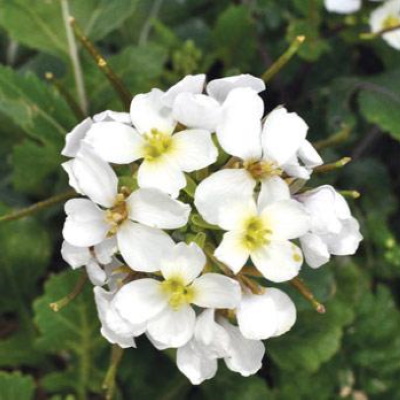

Perennial spicy flavoring plant. The leaves are thin, oblong, strongly serrated with walnut-mustard flavor. The period from germination to collect leaves is 20-25 days. Grown by sowing seeds in open ground. In the cooler months in full sun, and in the summer - in light shade. With regular watering the leaves become more tender and less taste bitter. Cutting is best done before flowering. Young, tender leaves are used in salads and as a garnish for sharp meat and fish dishes. Fresh leaves can be continuously harvested for various salads and yogurt dips.
-
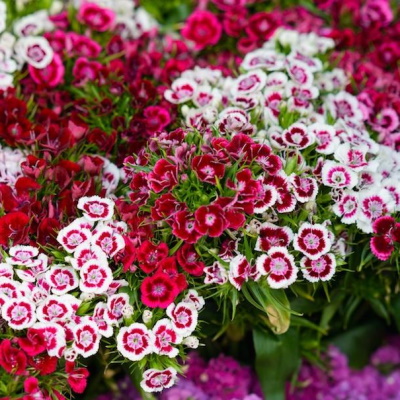 Sweet William Super Duplex is a Dianthus barbatus that produces an excellent perennial crossover bedding plant that makes an exceptional cut flower. Tall, 55 cm, blue-green sturdy stems are topped with tufted clusters of big double frilly fringed star-shaped flowers. This is a mix of solid and bi-color combinations of light pink, carmine, cherry, burgundy, purple and red. This dependable perennial variety is a show stopper in border, container, and pathway plantings, returning year after year with a smashing showcase of color. Hardy to zone 3
Sweet William Super Duplex is a Dianthus barbatus that produces an excellent perennial crossover bedding plant that makes an exceptional cut flower. Tall, 55 cm, blue-green sturdy stems are topped with tufted clusters of big double frilly fringed star-shaped flowers. This is a mix of solid and bi-color combinations of light pink, carmine, cherry, burgundy, purple and red. This dependable perennial variety is a show stopper in border, container, and pathway plantings, returning year after year with a smashing showcase of color. Hardy to zone 3 -
 Etournella Mix Sweet William is a Dianthus barbatus that produces an excellent bedding plant that makes an exceptional cut flower. Growing 45 cm high this Sweet William blooms earlier than other varieties. Perennial to zone 3 and has vivid colours in burgundy, pinks, rose and white and self-seeds. Cut spent flowers to promote more blossoms.
Etournella Mix Sweet William is a Dianthus barbatus that produces an excellent bedding plant that makes an exceptional cut flower. Growing 45 cm high this Sweet William blooms earlier than other varieties. Perennial to zone 3 and has vivid colours in burgundy, pinks, rose and white and self-seeds. Cut spent flowers to promote more blossoms. -
 This delightful Japanese Catmint has many merits. Both the foliage and the flowers are fragrant. It blooms the first year from seed, unlike most perennials. It is upright and nicely branched, rather than sprawling. Make it a centerpiece of your containers and sunny-to-partly-shaded garden areas! Sister to Panther Dark Blue which walked off with the Bronze Medal at Holland's prestigious Plantarium competition in 2015. The attractive little plant is much more compact than other catmint species, standing just 20 cm high and 25 cm wide. The foliage is bright green, glossy, and toothed, releasing a strong, heavenly fragrance from spring through fall. Profuse bloomer! Medium to dark pink, these tubular flowers reach up to 5 cm long, held in nice clusters on the top of the plant. The blossoms are fragrant, and they begin in early summer and go right through into early fall. You'll be amazed by the flower power of this petite plant.
This delightful Japanese Catmint has many merits. Both the foliage and the flowers are fragrant. It blooms the first year from seed, unlike most perennials. It is upright and nicely branched, rather than sprawling. Make it a centerpiece of your containers and sunny-to-partly-shaded garden areas! Sister to Panther Dark Blue which walked off with the Bronze Medal at Holland's prestigious Plantarium competition in 2015. The attractive little plant is much more compact than other catmint species, standing just 20 cm high and 25 cm wide. The foliage is bright green, glossy, and toothed, releasing a strong, heavenly fragrance from spring through fall. Profuse bloomer! Medium to dark pink, these tubular flowers reach up to 5 cm long, held in nice clusters on the top of the plant. The blossoms are fragrant, and they begin in early summer and go right through into early fall. You'll be amazed by the flower power of this petite plant. -
Out of stock
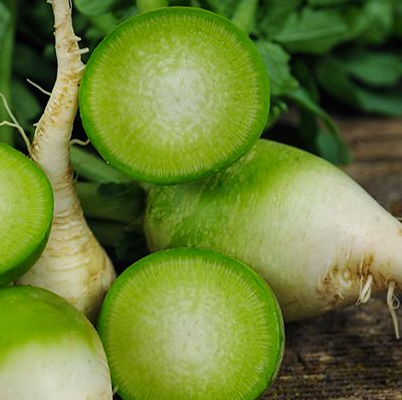 The unmistakably pungent flavor of wasabi can clear the sinuses and invigorate the palate. The energizing flavor found in plants like true wasabi and horseradish root can also be found in the Wasabi Radish of Japan. This is a medium-size oblong Daikon type radish packs a wallop of tingling wasabi heat. Add the peppery flavour to stir-fries and sandwiches or sliced paper-thin to enhance a salad or your favorite Asian recipe. Spring planting benefit is that you can let a couple of plants go to seed as their pods are delicious and pack immense heat. Sow early in spring but late in summer August-September when the soil is 18-22 C produces a great crop. Plenty of water and space helps prevent these delightful hot radishes from going woody.
The unmistakably pungent flavor of wasabi can clear the sinuses and invigorate the palate. The energizing flavor found in plants like true wasabi and horseradish root can also be found in the Wasabi Radish of Japan. This is a medium-size oblong Daikon type radish packs a wallop of tingling wasabi heat. Add the peppery flavour to stir-fries and sandwiches or sliced paper-thin to enhance a salad or your favorite Asian recipe. Spring planting benefit is that you can let a couple of plants go to seed as their pods are delicious and pack immense heat. Sow early in spring but late in summer August-September when the soil is 18-22 C produces a great crop. Plenty of water and space helps prevent these delightful hot radishes from going woody. -
Out of stock
 French Breakfast radish is known for its vibrant coloring which graduates from a vivid fuchsia-red to bright white at the tip. Topped with edible, leafy greens, French Breakfast radishes are very crisp and offer a mildly spicy flavor. French Breakfast is a very fast growing variety, with radishes ready for harvest within a month.
French Breakfast radish is known for its vibrant coloring which graduates from a vivid fuchsia-red to bright white at the tip. Topped with edible, leafy greens, French Breakfast radishes are very crisp and offer a mildly spicy flavor. French Breakfast is a very fast growing variety, with radishes ready for harvest within a month. -
Out of stock
 Antique horticultural treasure from China of unearthly beauty. Large 11-14 cm round roots that are creamy-white outside, with a vivid burst of watermelon-rose colour at the center. The flesh is crispy, mild, and refreshing, with a sweet flavor perfect for salads, garnishes, or even pickling. Enjoy roasted or sautéed with parsnips, carrots, and other fall root vegetables. Best grown in cool weather. Sow in late summer for a fall crop. This is a winter variety radish.
Antique horticultural treasure from China of unearthly beauty. Large 11-14 cm round roots that are creamy-white outside, with a vivid burst of watermelon-rose colour at the center. The flesh is crispy, mild, and refreshing, with a sweet flavor perfect for salads, garnishes, or even pickling. Enjoy roasted or sautéed with parsnips, carrots, and other fall root vegetables. Best grown in cool weather. Sow in late summer for a fall crop. This is a winter variety radish. -
Out of stock
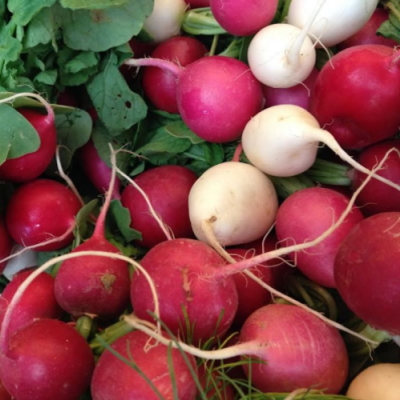 This type of radish can grow as large as a small apple without becoming woody. They require constant even moisture. Easter Egg II radish seeds are a blend of six different coloured radishes. The flesh is crispy and white yet mild, making great snacks for children and adults alike. The colours of the flesh are white, rose pink, bubblegum pink, amethyst, mauve, scarlet and purple roots. The roots are round and grow at a similar rate. Great for both for spring and fall growing. Try our planting method for radishes in groups of 3-4 seeds, pulling out the largest in each group. Sow in spring every 1-2 weeks to have a continual crop in the spring, but save some seed to sow again in late August for fall crops. Don't keep in the ground once they start to get woody or bolt.
This type of radish can grow as large as a small apple without becoming woody. They require constant even moisture. Easter Egg II radish seeds are a blend of six different coloured radishes. The flesh is crispy and white yet mild, making great snacks for children and adults alike. The colours of the flesh are white, rose pink, bubblegum pink, amethyst, mauve, scarlet and purple roots. The roots are round and grow at a similar rate. Great for both for spring and fall growing. Try our planting method for radishes in groups of 3-4 seeds, pulling out the largest in each group. Sow in spring every 1-2 weeks to have a continual crop in the spring, but save some seed to sow again in late August for fall crops. Don't keep in the ground once they start to get woody or bolt. -
Out of stock
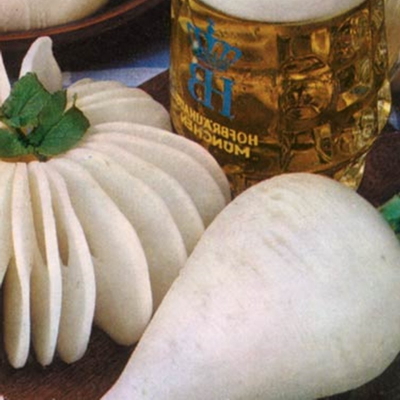
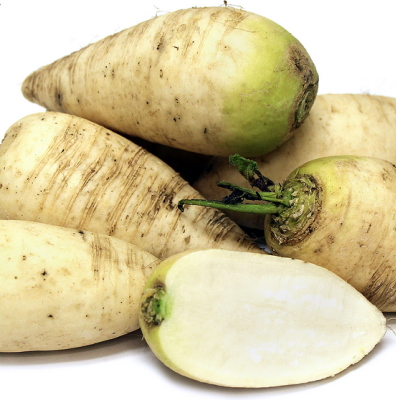 Mid-season variety (80-90 days). Large, oval, white roots, weight 200-500g. Fragrant white, dense, juicy, flesh with a spicy taste. Resistant to cracking. Can be stored up to 3 months. Sow in spring for fresh radishes in summer, sow in summer for winter storage. Pairs perfectly with beer, hence the name.
Mid-season variety (80-90 days). Large, oval, white roots, weight 200-500g. Fragrant white, dense, juicy, flesh with a spicy taste. Resistant to cracking. Can be stored up to 3 months. Sow in spring for fresh radishes in summer, sow in summer for winter storage. Pairs perfectly with beer, hence the name. -
Out of stock
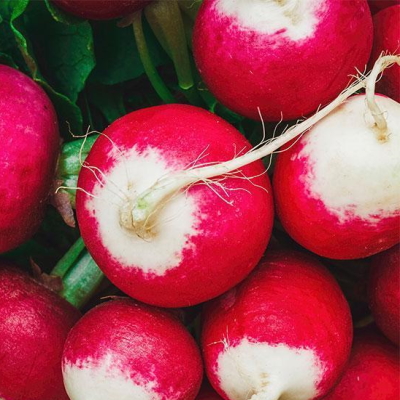 Heirloom Sparkler Radish Seeds. This fast cool-season crop is a delight with its pretty red skin that changes to white at the tip. Matures in 25 to 30 days. The bright but mild radish flavor is a crowd-pleaser and at 2.5-4 cm is great on a relish tray or eating out of hand.
Heirloom Sparkler Radish Seeds. This fast cool-season crop is a delight with its pretty red skin that changes to white at the tip. Matures in 25 to 30 days. The bright but mild radish flavor is a crowd-pleaser and at 2.5-4 cm is great on a relish tray or eating out of hand. -
Out of stock
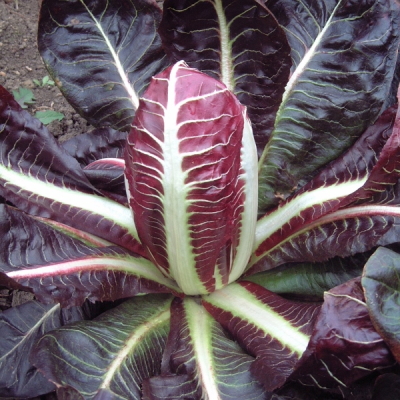 Rossa di Treviso is a prized Heirloom radicchio from Treviso Italy. It is very cold hardy and will add a striking colour to salads! Leaves start off green and then turn red contrasting beautifully against the thick white stripes and midribs as the weather cools. The tender, slightly bitter leaves are delicious in salads or sauteed with other vegetables. Believed to be good for insomnia and purifying the blood.
Rossa di Treviso is a prized Heirloom radicchio from Treviso Italy. It is very cold hardy and will add a striking colour to salads! Leaves start off green and then turn red contrasting beautifully against the thick white stripes and midribs as the weather cools. The tender, slightly bitter leaves are delicious in salads or sauteed with other vegetables. Believed to be good for insomnia and purifying the blood. -
Out of stock
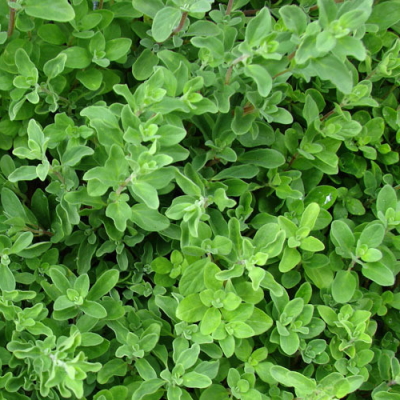 The attractive leaves of this tender perennial, which survives well in both an indoor and outdoor environment are delightfully sweet. They are slightly spicy tasting which is perfect for all meats, fish, and poultry. The pale pink flowers can be used in salads.
The attractive leaves of this tender perennial, which survives well in both an indoor and outdoor environment are delightfully sweet. They are slightly spicy tasting which is perfect for all meats, fish, and poultry. The pale pink flowers can be used in salads. -
Out of stock
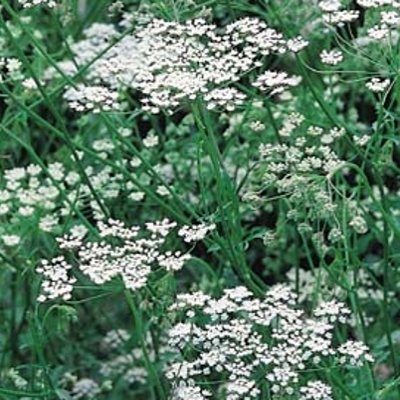 Anise is always grown in our gardens, they not only have attractive foliage but their seeds are harvested in our kitchens for soups, spreads, salad dressings, cakes, and cookies. Seeds and leaves carry a sweet, licorice-like flavor, make a comforting tea, or a tasty breath freshener. Many use Anise as a treatment for sore throats, indigestion, and flatulence. Anise essential oil is used to flavor licorice candy. Try the feathery leaves fresh in salads and soups. Umbrella-like clusters of tiny white flowers bloom in July, attract butterflies, bees, and beneficial insects. Seed heads attract birds.
Anise is always grown in our gardens, they not only have attractive foliage but their seeds are harvested in our kitchens for soups, spreads, salad dressings, cakes, and cookies. Seeds and leaves carry a sweet, licorice-like flavor, make a comforting tea, or a tasty breath freshener. Many use Anise as a treatment for sore throats, indigestion, and flatulence. Anise essential oil is used to flavor licorice candy. Try the feathery leaves fresh in salads and soups. Umbrella-like clusters of tiny white flowers bloom in July, attract butterflies, bees, and beneficial insects. Seed heads attract birds. -
Out of stock
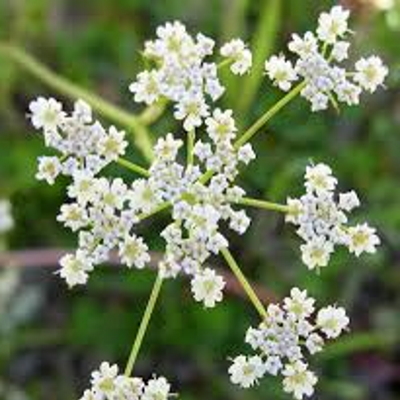 Caraway reveals its close family ties to carrot through its carrot-like, feathery foliage, and the long taproot it develops in the first year. Like the carrot (also a biennial), the plant stores energy in this root to send up a tall flower stalk in year two, which is followed by seeds for the next generation. Use the sweet foliage to flavour soups and salads, use the seeds to flavour bread and baked goods, and even use the carrot-like taproot as a regular root vegetable.
Caraway reveals its close family ties to carrot through its carrot-like, feathery foliage, and the long taproot it develops in the first year. Like the carrot (also a biennial), the plant stores energy in this root to send up a tall flower stalk in year two, which is followed by seeds for the next generation. Use the sweet foliage to flavour soups and salads, use the seeds to flavour bread and baked goods, and even use the carrot-like taproot as a regular root vegetable. -
Out of stock
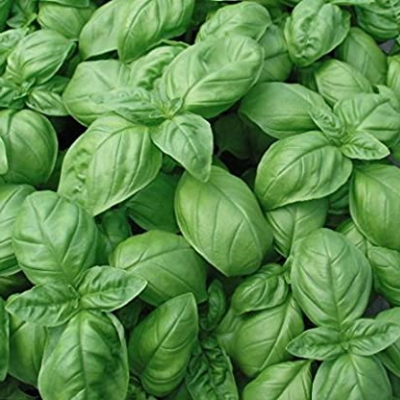 The most popular basil used in Pesto. Sweet basil is the most used of all basil varieties. It has a robust, aromatic, and spicy flavour that goes great with tomato-based dishes. Basil is an easy to grow herb that can be used for companion planting. Planting basil near tomato plants will help improve the flavour of tomatoes. Basil will also help attract predator insects that will prey on garden pests.
The most popular basil used in Pesto. Sweet basil is the most used of all basil varieties. It has a robust, aromatic, and spicy flavour that goes great with tomato-based dishes. Basil is an easy to grow herb that can be used for companion planting. Planting basil near tomato plants will help improve the flavour of tomatoes. Basil will also help attract predator insects that will prey on garden pests. -
Out of stock
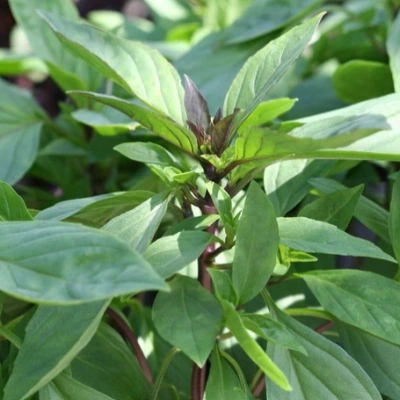 Thai basil seeds are the authentic heirloom basil variety that is native to southeast Asia. Highly regarded for its distinctive, spicy flavour. Vigorous, highly ornamental plants with purple stalks and flowers that open to pink, providing a nice contrast to its dark green leaves. This variety is particularly productive in hot weather, with plenty of moisture. This Basil loves water, sun, and heat. so grow in the hottest sunny location and provide plenty of water.
Thai basil seeds are the authentic heirloom basil variety that is native to southeast Asia. Highly regarded for its distinctive, spicy flavour. Vigorous, highly ornamental plants with purple stalks and flowers that open to pink, providing a nice contrast to its dark green leaves. This variety is particularly productive in hot weather, with plenty of moisture. This Basil loves water, sun, and heat. so grow in the hottest sunny location and provide plenty of water. -
Out of stock
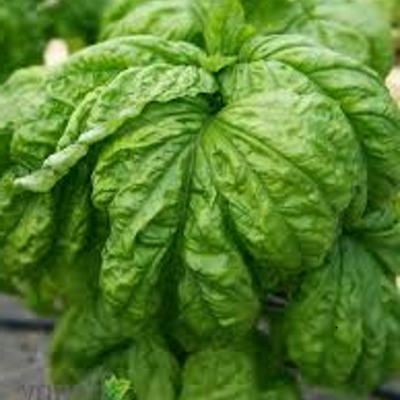 Lettuce Leaf basil seeds produce very large green leaves with a glorious aroma. One of the most popular and productive sweet basils. The large, bright green, crinkled leaves let off a delicious aroma. Great for salads, pestos, pizza, and sandwiches.
Lettuce Leaf basil seeds produce very large green leaves with a glorious aroma. One of the most popular and productive sweet basils. The large, bright green, crinkled leaves let off a delicious aroma. Great for salads, pestos, pizza, and sandwiches. -
Out of stock
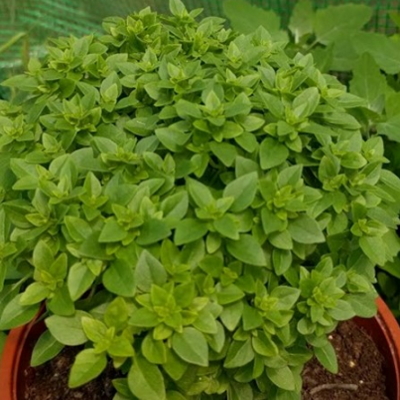 Jazz up your meals with Spicy Globe Basil. This Basil produces a tidy mound-shaped plant making attractive dense, bushy little plants. The 1 cm long leaves have a great spicy taste! This is a superb basil for growing in containers on hot, sunny patios. Seed can also be started indoors in a soil-less mix 4-6 weeks before the last frost date.
Jazz up your meals with Spicy Globe Basil. This Basil produces a tidy mound-shaped plant making attractive dense, bushy little plants. The 1 cm long leaves have a great spicy taste! This is a superb basil for growing in containers on hot, sunny patios. Seed can also be started indoors in a soil-less mix 4-6 weeks before the last frost date. -
Out of stock
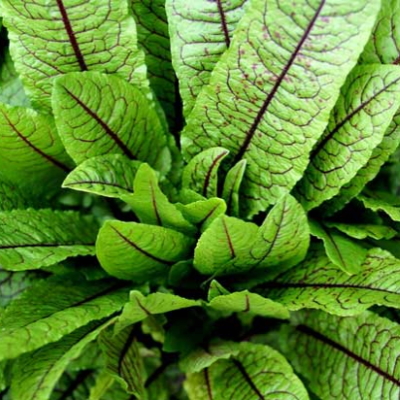 Bright green leaves with contrasting, dark maroon stems and veins. Same sharp, tangy flavor as regular sorrel. Best variety for indoor production. Best when harvested young for salad mix as large leaves are tough.
Bright green leaves with contrasting, dark maroon stems and veins. Same sharp, tangy flavor as regular sorrel. Best variety for indoor production. Best when harvested young for salad mix as large leaves are tough. -
Out of stock
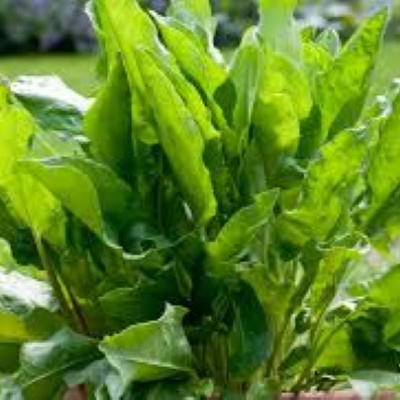 Rumex acetosa) 35 days (baby), 50 days (mature) - Perennial in zones 4-9. French Lemon Sorrel is a must-have for no-hassle gardeners. Able to establish itself as a perennial in a wide range of Canada Sorrel is one of the earliest and latest greens in your garden coming up on its own at the beginning of spring. Each tender leaf is up to eight inches long and has a delicious lemon flavour. This is a great all-around open-pollinated sorrel variety, adaptable to any home organic vegetable garden.
Rumex acetosa) 35 days (baby), 50 days (mature) - Perennial in zones 4-9. French Lemon Sorrel is a must-have for no-hassle gardeners. Able to establish itself as a perennial in a wide range of Canada Sorrel is one of the earliest and latest greens in your garden coming up on its own at the beginning of spring. Each tender leaf is up to eight inches long and has a delicious lemon flavour. This is a great all-around open-pollinated sorrel variety, adaptable to any home organic vegetable garden. -
Out of stock
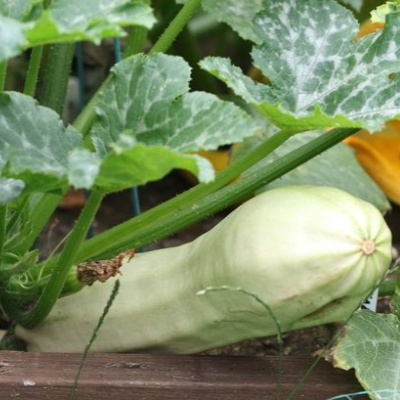 Bush plants are compact and a perfect fit for gardeners with limited space. Vegetable Marrow is a semi bush with some vining. It produces pale yellow oval squash that may or may not have distinguishable ridges and can show some substantial differences in fruit coloration from very pale yellow to greenish-white, to darker green, to pale greenish-white with darker green stripes. They are hard-shelled when mature at 25-36cm. Beneath the hard white skin is a creamy interior that is wonderful for stuffing and baking. Vegetable Marrow squash seeds are a Lebanese type of squash and can be picked young when pale green and used like summer squash. Plants are prolific and will produce over a long summer season if kept picked. Leave this squash to cure outside for about a week before storing it. Squash is easy to grow and to harvest. Harvest all squash before your first frost.
Bush plants are compact and a perfect fit for gardeners with limited space. Vegetable Marrow is a semi bush with some vining. It produces pale yellow oval squash that may or may not have distinguishable ridges and can show some substantial differences in fruit coloration from very pale yellow to greenish-white, to darker green, to pale greenish-white with darker green stripes. They are hard-shelled when mature at 25-36cm. Beneath the hard white skin is a creamy interior that is wonderful for stuffing and baking. Vegetable Marrow squash seeds are a Lebanese type of squash and can be picked young when pale green and used like summer squash. Plants are prolific and will produce over a long summer season if kept picked. Leave this squash to cure outside for about a week before storing it. Squash is easy to grow and to harvest. Harvest all squash before your first frost. -
Out of stock
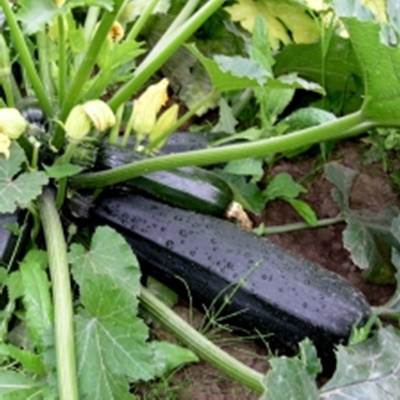 Matures in 60 days. The standard summer squash was introduced in the 1920s. Plants are productive very early and produce until feeze-up if kept picked. Best eaten when under 20cm. Black Beauty zucchini seeds are a great variety for freezing. Black Beauty zucchini is a 20th Century heirloom that won the All-American Selections prize back in 1957. It was first introduced to American market growers in the 1920s. Direct sow or transplant in late May or early June when the soil is warm. For transplants, start seeds indoors in late April or early May. Optimal soil temperature for germination: 25-35°C. Seeds should sprout in 7-14 days.
Matures in 60 days. The standard summer squash was introduced in the 1920s. Plants are productive very early and produce until feeze-up if kept picked. Best eaten when under 20cm. Black Beauty zucchini seeds are a great variety for freezing. Black Beauty zucchini is a 20th Century heirloom that won the All-American Selections prize back in 1957. It was first introduced to American market growers in the 1920s. Direct sow or transplant in late May or early June when the soil is warm. For transplants, start seeds indoors in late April or early May. Optimal soil temperature for germination: 25-35°C. Seeds should sprout in 7-14 days. -
Out of stock
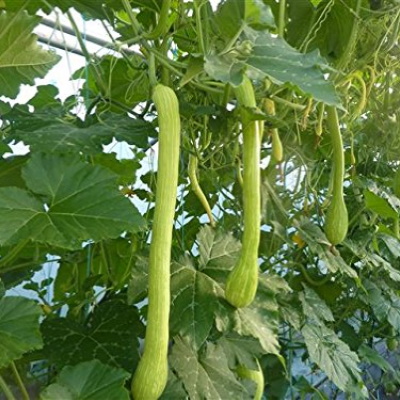 Although an old-fashioned Italian variety this is a favourite with gardeners as it is one of the very few remaining trailing type courgettes. It can be left to grow along the ground like pumpkins or trained up a trellis where space is limited. . Tender pale green summer squash The seeds are contained in the bulbous cavity at the flower end of the courgette and the flesh along the main very long fruit is dense. A delicious courgette climbing variety which is early and prolific. Easy to grow outdoors, excellent flavour. If grown up a trellis as in the photo they can attain over a meter in length without losing flavour, unlike traditional courgettes. If theft to grow along the ground they tend to curl and twist looking very much like a green snake or serpent! These courgettes are a wow and will amaze your gardening and gourmet chef friends with their shape, colour, and taste. Perfect for the barbecue, cooked with olive oil, grated raw in salads, or cooked with onions, tomatoes, and aubergines for a traditional Mediterranean ratatouille.
Although an old-fashioned Italian variety this is a favourite with gardeners as it is one of the very few remaining trailing type courgettes. It can be left to grow along the ground like pumpkins or trained up a trellis where space is limited. . Tender pale green summer squash The seeds are contained in the bulbous cavity at the flower end of the courgette and the flesh along the main very long fruit is dense. A delicious courgette climbing variety which is early and prolific. Easy to grow outdoors, excellent flavour. If grown up a trellis as in the photo they can attain over a meter in length without losing flavour, unlike traditional courgettes. If theft to grow along the ground they tend to curl and twist looking very much like a green snake or serpent! These courgettes are a wow and will amaze your gardening and gourmet chef friends with their shape, colour, and taste. Perfect for the barbecue, cooked with olive oil, grated raw in salads, or cooked with onions, tomatoes, and aubergines for a traditional Mediterranean ratatouille.
